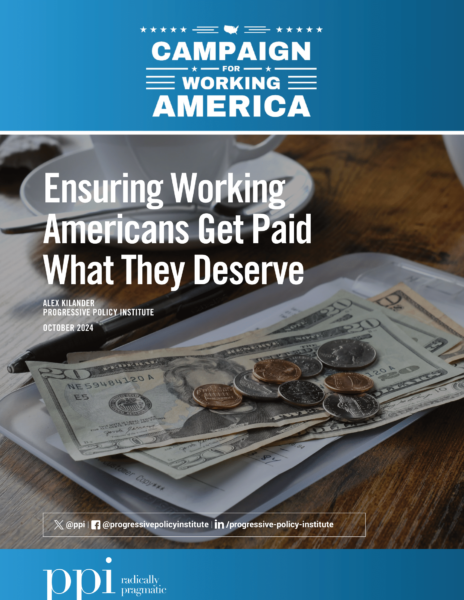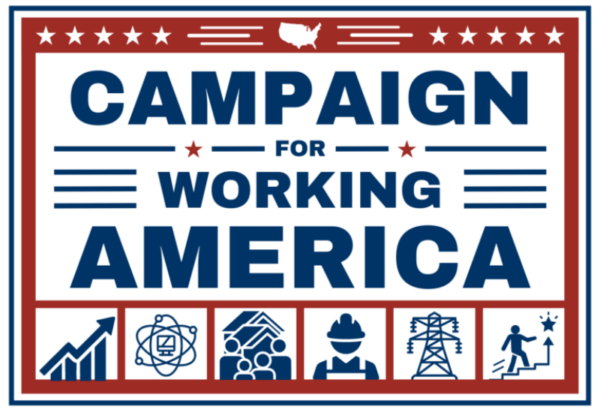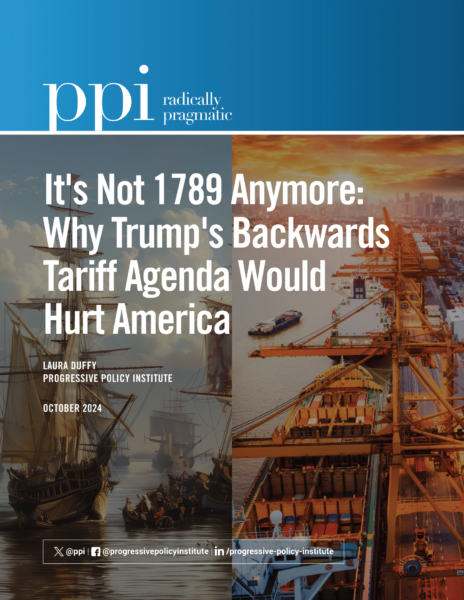From October 21–25, 2024, a delegation from the Progressive Policy Institute (PPI) traveled to Argentina and Uruguay to discuss the role of artificial intelligence (AI) in the App Economy and its potential to drive economic growth. This trip, led by PPI’s Chief Economist Dr. Michael Mandel and Director for Trade and Global Markets Ed Gresser, featured high-level meetings with government officials, academic leaders, and key players in the tech and business sectors. The delegation emphasized AI’s potential to revolutionize industries ranging from agriculture to finance and underscored the need for supportive policies that foster innovation and job growth.
As Argentina faces continued economic challenges, there is a growing recognition of the App Economy as a source of sustainable employment. This report summarizes key takeaways from PPI’s engagements in Argentina and Uruguay, focusing on themes of innovation, AI integration, and cross-border economic collaboration.
Buenos Aires, Argentina – October 21, 2024
CEDES (Centro de Estudios de Estado y Sociedad)
PPI’s first meeting in Argentina was with the think tank CEDES, where discussions centered around Argentina’s broader political and economic landscape, which gave the delegation a foundational understanding of how Argentina’s economy evolved to the state that it’s in today. and the potential for digital transformation to drive job creation. Key themes included the need for lowering inflation while simultaneously raising prices, and what would constitute a successful economic term for Argentinian President Milei.
Meet & Greet with Professors at Universidad Torcuato Di Tella
During this discussion, faculty members emphasized that “this time it’s different”—suggesting that innovation in AI and the App Economy should not be viewed through the same lens as traditional industrial technologies. The group discussed new opportunities from handling more granular, disaggregated data and the unique challenges and potential of such innovations. While development of technologies has often taken center stage, there was acknowledgment that less attention has been paid to how technologies will be adopted in practice, which will be crucial for maximizing the impact of AI and app development on Argentina’s economy.
Buenos Aires, Argentina – October 22, 2024
CIPPEC (Centro de Implementación de Políticas Públicas para la Equidad y el Crecimiento)
At CIPPEC, discussions centered on Argentina President Javier Milei’s platform of reducing inflation, dollarizing the economy, and minimizing the privileges of the political elite. While banking and insurance sectors have shown some resilience, the broader economy has not yet rebounded, and uncertainty remains prevalent. Despite this, Milei retains relatively high approval ratings as president, albeit within a climate marked by political violence and threats. The group explored how AI and tech-driven growth could potentially contribute to stabilizing Argentina’s economy amid these challenges.
Argentina Council for International Relations (CARI)
At CARI, the discussion focused on Milei’s success in advocating for fiscal responsibility, marking a shift towards pragmatism in Argentina’s economic approach. There is optimism that Milei’s policies may yield economic growth by the end of 2024, aligning with PPI’s emphasis on long-term digital economy strategies. CARI representatives expressed confidence in Milei’s methods as practical solutions to Argentina’s ongoing economic issues and highlighted the potential for a tech-driven economic boost in the near term.
Argentine Foreign Ministry, US Division (Dirección de Relaciones Económicas con América del Norte – DIANE)
The discussion with the Argentine Foreign Ministry’s U.S. Division focused on strengthening US-Argentina trade relations in both the tech services sector and in basic goods. The group examined how the trade relationship between the two nations could differ following the result of the U.S. presidential election, and how policies like the CHIPS Act impact Argentina.
Argentine Economic Ministry
The PPI team met with the Economic Ministry to discuss Argentina’s trade policy. In recent years, Argentina has faced challenges in liberalizing international trade, but there is a focus on lowering import tariffs and increasing trade volume with the support of the central bank. Although a temporary tax was introduced on imports to fund the pandemic response, it has not yet been fully repealed, highlighting ongoing fiscal considerations. The ministry underscored its intention to continue reducing tax rates to support economic recovery.
PPI Salon Dinner at Cabaña Las Lilas: Fostering Conversations on AI and Economic Growth
On the evening before the event hosted at Etermax in the Villa Urquiza neighborhood of Buenos Aires, PPI hosted a private salon dinner at Cabaña Las Lilas, bringing together a select group of Argentine government officials, tech industry leaders, and software developers. The dinner, which began with a cocktail hour, provided a relaxed setting for off-the-record discussions on the future of the global tech economy and the role of AI in Argentina’s economic landscape.
Participants explored ideas on how government policies could support tech industry growth and addressed challenges unique to the region. This dinner served as a platform for fostering collaboration and building connections among key stakeholders ahead of the formal presentations at Etermax the following day.
Buenos Aires, Argentina – October 23, 2024
“Argentina: AI and the App Economy”
PPI, in partnership with the Argentine Chamber of the Software Industry (CESSI), hosted an event at Etermax headquarters titled “Argentina: AI and the App Economy.” This gathering brought together policymakers, industry leaders, and app developers to discuss the intersection of AI and the App Economy in Argentina. Dr. Michael Mandel presented his latest findings on employment trends in Argentina’s App Economy.
The event featured keynote remarks by Marcos Ayerra, Secretary of SMEs, Entrepreneurs, and Knowledge Economy, who spoke on the government’s efforts to position Argentina as a tech innovation hub. Máximo Cavazzani, CEO of Etermax, delivered a presentation in which he shared insights into AI applications within Argentina’s tech sector. Dr. Mandel then concluded the event by moderating a panel discussion with an app developer and leading AI expert on the role of AI and the app economy in Argentina.
Watch the full event recording.
Montevideo, Uruguay – October 24, 2024
Meeting with Ambassador Pablo Porro and Juan Labraga at the Ministry of Foreign Affairs and the Advisory Trade Policy Unit
This meeting focused on Uruguay’s trade and foreign policy initiatives, including relations with the U.S., Mercosur partners Brazil and Argentina, and China, to give the delegation a sense of Uruguay’s economic position in the world and what their international trade goals are. The Ambassador shared that Uruguay’s primary interest is to have market access for trade negotiations with the US and other large countries. Uruguay does not have a Free Trade Agreement (FTA) with the US, and Buy-American rules preclude their contribution to recent U.S. industrial strategy programs developed in the CHiPS Act and the Inflation Reduction Act. They are successful exporters of software to the US, and would like to generate increased investment from multinational tech companies.
Meeting with Uruguay XXI: Investment, Export, and Country Brand Promotion Agency
In Montevideo, PPI met with Uruguay XXI to discuss Uruguay’s investment climate and initiatives to attract tech companies. Discussions touched on what Uruguay has to offer the world in terms of investment potential and what role the US does and could play. They shared that while the US is the fifth-ranking destination for Uruguay’s exports of goods (principally beef and other farm products such as honey), Americans are the top partner for services, which comprise 30% of total exports. More than 80% of Uruguay’s IT services exports go to the US. A recent foreign investment breakthrough was an $850 million investment from Google in building a data center in Uruguay. Relevant to the group was also the opening of a Microsoft AI innovation hub lab. Uruguay XXI stressed that their investment grade is high and their country risk is the lowest in the region as reasons why FDI is continuing to rise.
Montevideo, Uruguay – October 25, 2024
Meeting with CUTI (Chamber of Information and Communication Technology Companies)
This meeting with Uruguay’s largest technology industry group centered on Uruguay’s tech sector, particularly in software development and AI. They are supported by 400 member companies, frequently collaborate with Parliament on laws that might affect the industry and with government agencies to help grow innovation. CUTI shared that Uruguay is doing well in terms of providing IT services, and that they’d like to add more startups and intellectual property to continue growing and adding jobs. A key takeaway was that Uruguay’s international tech sales are mostly selling to tech companies and startups and they’d like to sell more directly to industries.
Meeting with CERES (Center for Studies of Economic and Social Reality)
PPI next met with CERES, a centrist think tank created in 1985 after a military government fell and was replaced by a democratic system. They gave the group an in-depth breakdown of the current government’s makeup and ideological evolution, as well as insight into the Uruguayan elections later that weekend. This involved a second-round presidential vote, and a controversial (and ultimately unsuccessful) pension referendum. They detailed what they’d be looking for in terms of relations with Uruguay from a Harris administration, and expressed concerns about the effect on commodity prices for Uruguay if the role of the US in international conflicts were to be destabilized.
Meeting with CED (Center for Economic Development)
To cap off the trip, PPI met with CED, the Center for Economic Development. A center-right think[-tank, they continued to reiterate the economic and political themes that had been expressed throughout the visit, and gave further insight into the recent slowdown in Uruguayan economic growth. CED highlighted political stability and strong institutions as Uruguay’s strong points, while outlining their vision for a more sustainable economic growth plan in the near future. They emphasized that their objective in the next year is to consolidate the high levels of employment and aim for the Central Bank’s 3% inflation rate target in order to foster this economic growth.
Conclusion: Toward a Stronger Regional App Economy
PPI’s delegation trip underscored the opportunities for Argentina and Uruguay to emerge as leaders in the AI-driven App Economy. By fostering supportive policies, investing in talent development, and encouraging cross-border collaborations, both countries stand to benefit from the global tech boom. This visit provided valuable insights and strengthened PPI’s ties with policymakers, academic leaders, and industry experts committed to advancing digital innovation throughout Latin America.








